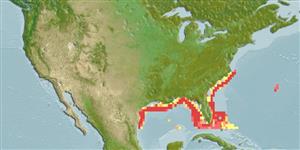Teleostei (teleosts) >
Perciformes/Scorpaenoidei (Scorpionfishes) >
Triglidae (Searobins) > Prionotinae
Etymology: Prionotus: Greek, prion, -onos = saw + Greek, noton = back (Ref. 45335).
Eponymy: Silas Stearns was an amateur ichthyologist who worked at the Warren Fish Company in Pensacola, Florida. [...] (Ref. 128868), visit book page.
More on authors: Jordan & Swain.
Environment: milieu / climate zone / depth range / distribution range
Ecology
Marine; demersal; depth range 37 - 300 m (Ref. 5217), usually 73 - 180 m (Ref. 7251). Subtropical; 37°N - 24°N
Western Atlantic: North Carolina and northern Gulf of Mexico to southern Florida in USA; northern coast of South America (Ref. 5217).
Size / Weight / Age
Maturity: Lm ? range ? - ? cm
Max length : 17.5 cm TL male/unsexed; (Ref. 7251)
Inhabits offshore waters, mostly from 73-180 m depth. Minimum depth from Ref. 26912.
Life cycle and mating behavior
Maturity | Reproduction | Spawning | Eggs | Fecundity | Larvae
Robins, C.R. and G.C. Ray, 1986. A field guide to Atlantic coast fishes of North America. Houghton Mifflin Company, Boston, U.S.A. 354 p. (Ref. 7251)
IUCN Red List Status (Ref. 130435: Version 2025-1)
Threat to humans
Harmless
Human uses
Fisheries: bycatch
Tools
Special reports
Download XML
Internet sources
Estimates based on models
Preferred temperature (Ref.
123201): 17.8 - 23.9, mean 20.5 °C (based on 30 cells).
Phylogenetic diversity index (Ref.
82804): PD
50 = 0.5000 [Uniqueness, from 0.5 = low to 2.0 = high].
Bayesian length-weight: a=0.00525 (0.00223 - 0.01237), b=3.13 (2.92 - 3.34), in cm total length, based on LWR estimates for this (Sub)family-body shape (Ref.
93245).
Trophic level (Ref.
69278): 3.5 ±0.5 se; based on size and trophs of closest relatives
Resilience (Ref.
120179): High, minimum population doubling time less than 15 months (Preliminary K or Fecundity.).
Fishing Vulnerability (Ref.
59153): Low vulnerability (10 of 100).
🛈
